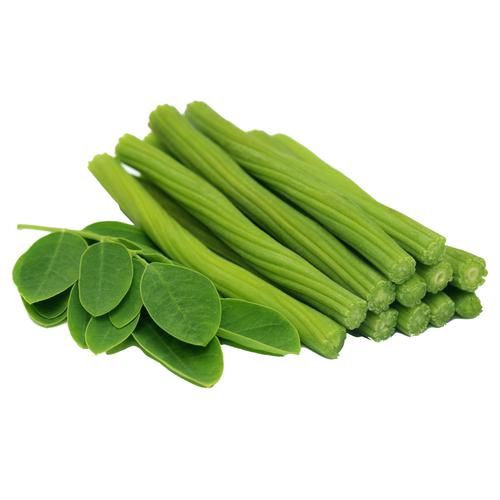Moringa drumstick
Moringa drumstick
Couldn't load pickup availability
The pods of the Drumstick or Moringa tree are long, smooth-skinned, dark green, and three-sided. The pods, which can reach anywhere from 6 to 18 inches in length, are soft when mature and have bumps that run the length of the pod, revealing the seed nodes. Within the pods is a fleshy pulp and pea-sized seeds encased in wing-shaped hulls. The Drumsticks are tapered at each end. Moringa pods are bitter with a somewhat sweet taste; their muted flavor allows for a variety of seasoning options.
Seasons/Availability
Drumstick pods are available year-round in warmer, tropical regions.
Current Facts
Moringa oleifera, is known as the Drumstick tree for its long pods that resemble drumsticks. The pods of the taller, more mature trees are consumed as are the root, and leaves. It is sometimes called the ben-oil tree for its seed oil which is non-drying and is used as a watch lubricant and paint base. Along with industrial uses, the tree has Ayurvedic properties, anti-bacterial and detoxifying properties. The roots possess a horseradish flavor, and in the west the plant is referred to as the ‘Horseradish Tree’ despite the fact that horseradish comes from an entirely different plant species.
Nutritional Value
Drumstick pods are rich in nutrients like iron, vitamin c, beta-carotene, copper and iodine.
Applications
Young Drumstick pods are ready to eat when they snap apart when bent in half. If the pod is too old, it becomes fibrous and woody. Drumstick pods are typically prepared by cutting into one or two inch pieces and adding to soups, curries, and Sambhar. They are pickled, boiled, steamed, and fried. Drumsticks can be prepared much like green beans or asparagus. The pods can be sliced lengthwise and the pulp scooped out and eaten; in India this is a delicacy.
Ethnic/Cultural Info
In Ayurveda, there are 300 different medicinal uses of the drumstick plant. The flowers, leaves and roots are used as folk remedies for cancer. In the Philippines, the pods are known as malunggay.
Geography/History
The Drumstick plant was reportedly first cultivated in 2000 BC. The Drumstick plant is native to India, Arabia and parts of Africa, though it is mostly grown in Pakistan and India. Drumsticks are in high demand in Singapore, and throughout India for its healing properties and many culinary uses.
Price is for 6 seeds


Collapsible content
Fair Use Disclaimer
Our website may contain content not authorized for use by its owner but use of this material falls under the guidelines of fair use (They are for educational purposes only to show the plant only).
If you want to find our more or own any images displayed on our website and disagree with our assessment it constitutes 'fair use' please click here.


